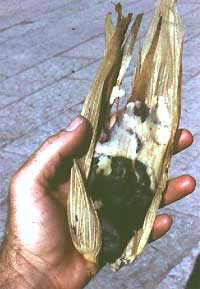
When you're wandering around the mercado seeing interesting, tasty-looking items being prepared and sold informally as seen above, you wonder if it's safe for people with stomachs populated with bacterial floras different from those of Mexicans to eat mercado food without getting sick?
Well, it can be tricky.
I have enjoyed a rainbow of fruits and vegetables from mercados, and patronized so many mercado eateries, or comedores, as well as street-side comales, that now my stomach bacteria is thoroughly mestizo; I can eat real Mexican food and hardly ever get sick. However, it is true that this license has been purchased with many youthful days of stomach cramps and diarrhea.
YOU MIGHT TRY THIS...
Over the years several people have told me that they have avoided diarrhea by supplementing their food with large quantities of safe bacteria specifically adapted to the human intestinal tract. You can further protect yourself by taking capsules filled with activated charcoal, which are available in many local health stores -- or make them yourself!
In fact, any traveler stands a very good chance of getting ill if he or she eats mercado food without proper precautions. Individuals with delicate stomachs might get sick no matter what measures they take. In my own early days I just assumed that I would contract Montezuma's revenge as soon as I arrived in Mexico, so at the beginning of every trip I would eat whatever I wanted and simply be sure that during my first couple of days I never strayed far from an agreeable toilet. Once my stomach was "inoculated," I usually had it made until the next trip. I have noted, however, that this strategy does not work with everyone. Once I contracted Hepatitis A from contaminated water; now that can be prevented by being inoculated before visiting less developed areas. Here are some general rules for eating in the mercado environment.
First of all, never trust Mexican tapwater, even if it flows in a fancy hotel in Mexico City. Buy your water. Because I eat simple food like tortillas, beans and scrampled eggs, in hotter parts of Mexico typically I spend more money on water than on food. Bottles and jugs of purified water are available in most supermarkets.
Potatoes, yams, jícamas, squash, greens, and the like purchased in mercados will be sterile after cooking for several minutes in boiling water; just avoid recontaminating the food with dirty fingers or eating utensils. Cutting the skin or peel from items like apples, carrots, and mangoes removes most bacteria, but always some germs are transferred from the skin into the item's interior by the knife itself, and by fingers holding the peeled part. This problem can be overcome by washing fruit, knife, and hands very thoroughly, and by soaking food items in water in which iodine or chlorine has been added in prescribed concentrations. By soaking vegetables such as lettuce and tomatoes in iodine or chlorine solutions, it's even possible to make salads from mercado produce, but it requires a deft touch to both kill the bacteria, and keep the salad from tasting like the chemical.
Never eat fruits such as melons or mangoes with worm holes or even very minor-looking cuts through the skins. Never eat discolored parts of any fruit. One of my most spectacular cases of diarrhea resulted from eating a slice of watermelon with just the most subtle brownish discoloration in the general area of a tiny worm hole through the rind.
 Tamal de plátano con queso, a banana and cheese tamale wrapped in corn shucks, in Mexico City; copyright-free image courtesy of "Pequeño mar" via Wikimedia Commons.
Tamal de plátano con queso, a banana and cheese tamale wrapped in corn shucks, in Mexico City; copyright-free image courtesy of "Pequeño mar" via Wikimedia Commons.Should one eat steaming-hot tamales wrapped in corn shucks, such as the one shown at the right? I would if I saw it being taken from the steamer in which it had been steamed, and steamed corn shucks are as good at keeping tamales sterile as any napkin.
Street-side purchased items like tacos, quesadillas, and huaraches are riskier, even if you see them being sizzled in oil before you. Problems arise when ingredients such as shredded cheese and hot-sauce are added from cups and saucers which may have been sitting for ages in the open air. Also, the cook's hands and the saucer onto which the item is served may be contaminated. Some cooks, even a few with nothing but a knee-high comal set up alongside the street, keep their saucers well washed, serve their food on sterile napkins, and even wear plastic gloves or bags over their hands. Such folks are wonderful to find, and they are worth looking for.
Ice in any form around the mercado is suspect because one never knows what kind of water it has been made from. I have seen ice made from purified water and destined for people's drinks scooted across a dirty floor by a man in dirty boots, and the man had a runny nose! Fruit drinks are sometimes diluted with contaminated water. I even suspect the pedigree of most street-side ice cream.
One secret to safely consuming comedor food is to use your eyes. Look for yourself to see if the coffee and stew you would like to have are being kept steaming hot, and therefore probably sterile. Watch whether utensils are being properly washed and dried with clean cloths. Is the cook washed-looking, and not touching the food with hands which have just handled pesos paid by a customer? A quick glance usually suffices to size up a place. Typically it is either grossly unhygienic, or sparklingly sterile, because most cooks seem either to be conscientious of such things, or else blithely unconcerned.